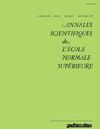Applications of forcing theory to homeomorphisms of the closed annulus
IF 1.6
1区 数学
Q1 MATHEMATICS
引用次数: 5
Abstract
This paper studies homeomorphisms of the closed annulus that are isotopic to the identity from the viewpoint of rotation theory, using a newly developed forcing theory for surface homeomorphisms. Our first result is a solution to the so called strong form of Boyland's Conjecture on the closed annulus: Assume $f$ is a homeomorphism of $\overline{\mathbb{A}}:=(\mathbb{R}/\mathbb{Z})\times [0,1]$ which is isotopic to the identity and preserves a Borel probability measure $\mu$ with full support. We prove that if the rotation set of $f$ is a non-trivial segment, then the rotation number of the measure $\mu$ cannot be an endpoint of this segment. We also study the case of homeomorphisms such that $\mathbb{A}=(\mathbb{R}/\mathbb{Z})\times (0,1)$ is a region of instability of $f$. We show that, if the rotation numbers of the restriction of $f$ to the boundary components lies in the interior of the rotation set of $f$, then $f$ has uniformly bounded deviations from its rotation set. Finally, by combining this last result and recent work on realization of rotation vectors for annular continua, we obtain that if $f$ is any area-preserving homeomorphism of $\overline{\mathbb{A}}$ isotopic to the identity, then for every real number $\rho$ in the rotation set of $f$, there exists an associated Aubry-Mather set, that is, a compact $f$-invariant set such that every point in this set has a rotation number equal to $\rho$. This extends a result by P. Le Calvez previously known only for diffeomorphisms.强迫理论在闭合环的同胚中的应用
本文从旋转理论的角度,利用新提出的表面同胚强迫理论,研究了同胚同位素闭合环的同胚。我们的第一个结果是闭环上所谓的强形式Boyland猜想的一个解:假设$f$是$\overline{\mathbb{A}}:=(\mathbb{R}/\mathbb{Z})\times [0,1]$的同胚,它是恒等式的同位素,并且保留了一个完全支持的Borel概率测度$\mu$。证明了如果$f$的旋转集是一个非平凡段,则测度$\mu$的旋转数不能是这个段的端点。我们也研究了同胚的情况,使得$\mathbb{A}=(\mathbb{R}/\mathbb{Z})\times (0,1)$是$f$的一个不稳定区域。我们证明,如果$f$对边界分量的限制的旋转数位于$f$的旋转集的内部,则$f$与其旋转集具有一致有界的偏差。最后,结合最近关于环形连续体旋转向量实现的工作,我们得到了如果$f$是$\overline{\mathbb{A}}$同位素对恒等式的任意保面积同胚,那么对于$f$的旋转集中的每一个实数$\rho$,存在一个关联的Aubry-Mather集合,即紧致$f$ -不变集合,使得该集合中每一点的旋转数都等于$\rho$。这扩展了P. Le Calvez先前只知道微分同态的结果。
本文章由计算机程序翻译,如有差异,请以英文原文为准。
求助全文
约1分钟内获得全文
求助全文
来源期刊
CiteScore
3.00
自引率
5.30%
发文量
25
审稿时长
>12 weeks
期刊介绍:
The Annales scientifiques de l''École normale supérieure were founded in 1864 by Louis Pasteur. The journal dealt with subjects touching on Physics, Chemistry and Natural Sciences. Around the turn of the century, it was decided that the journal should be devoted to Mathematics.
Today, the Annales are open to all fields of mathematics. The Editorial Board, with the help of referees, selects articles which are mathematically very substantial. The Journal insists on maintaining a tradition of clarity and rigour in the exposition.
The Annales scientifiques de l''École normale supérieures have been published by Gauthier-Villars unto 1997, then by Elsevier from 1999 to 2007. Since January 2008, they are published by the Société Mathématique de France.

 求助内容:
求助内容: 应助结果提醒方式:
应助结果提醒方式:


